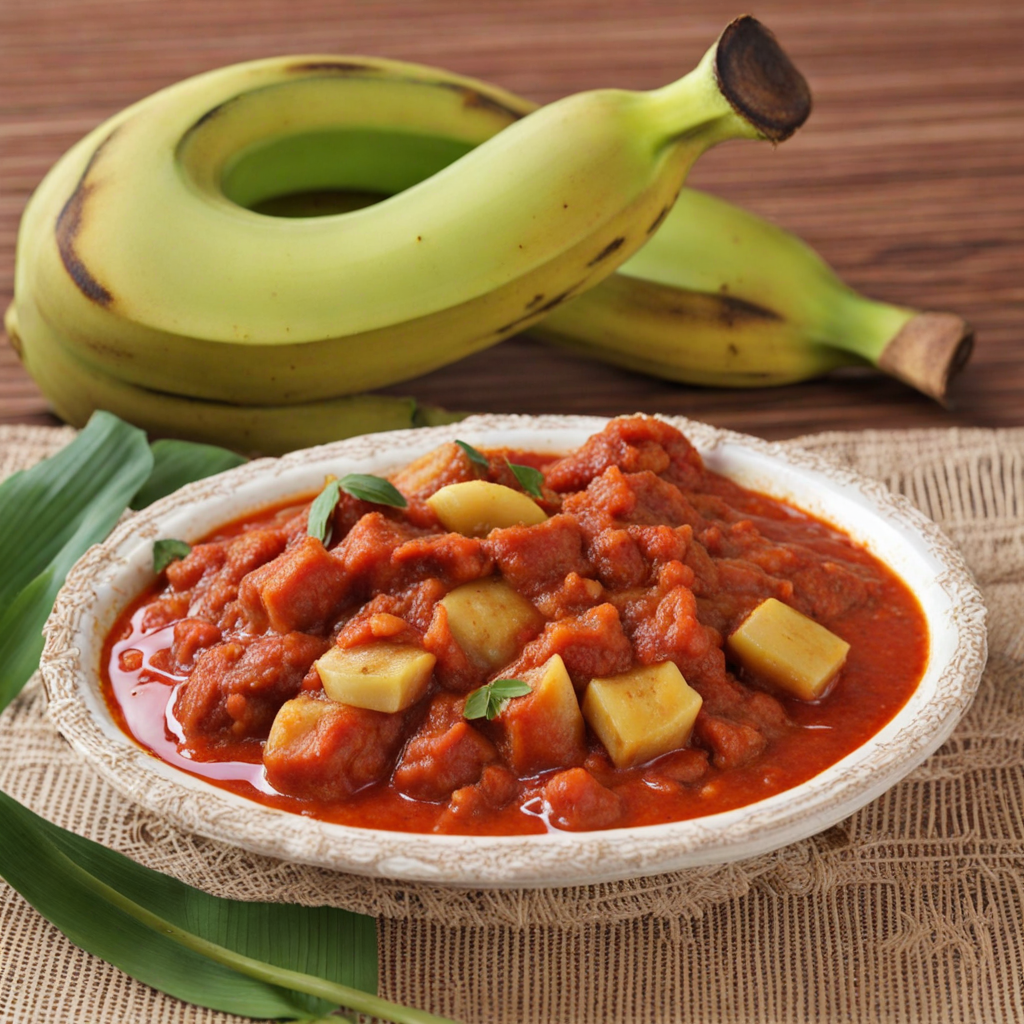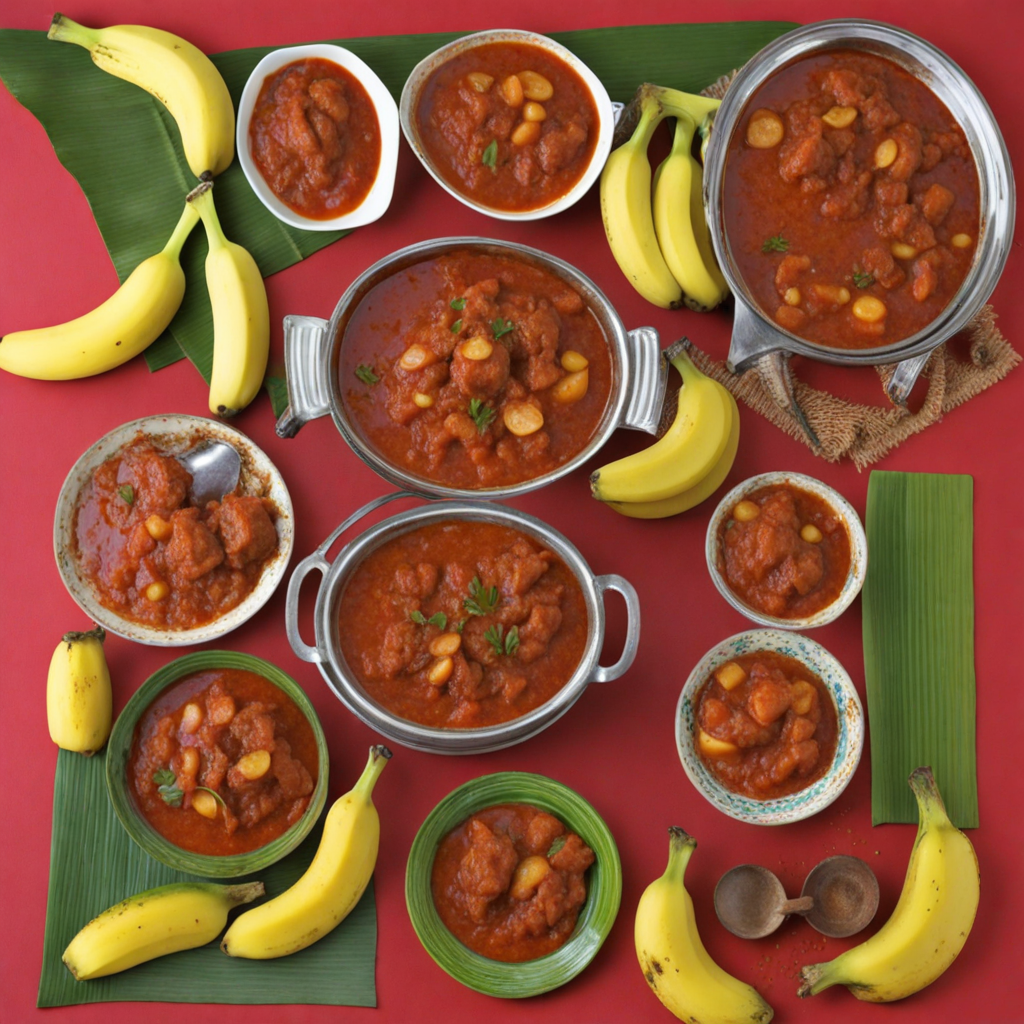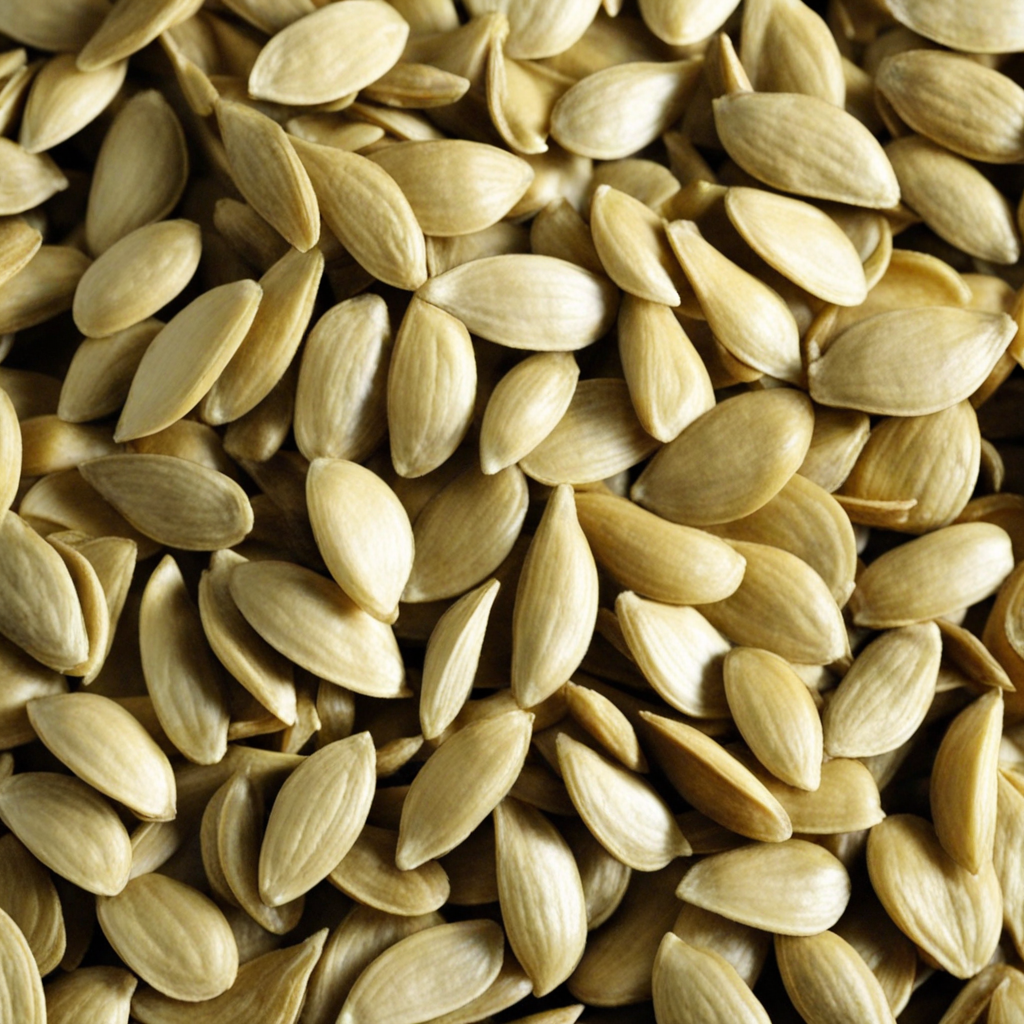Banana Stew
Banana Stew, a traditional dish from Burundi, is a delightful celebration of flavors and textures that showcases the country's agricultural bounty. This hearty stew primarily features green bananas, which are boiled until tender, creating a soft, creamy consistency that serves as the base of the dish. The bananas are often complemented by a variety of local ingredients such as onions, tomatoes, and peppers, which add depth and vibrancy. The subtle sweetness of the bananas balances beautifully with the savory elements, creating a unique flavor profile that is both comforting and satisfying. To enhance the dish, spices such as garlic, ginger, and sometimes a hint of chili are introduced, providing a gentle warmth that enlivens the palate. The stew may also incorporate meats, such as beef or chicken, which are simmered to infuse their rich flavors into the mix. The combination of ingredients is slow-cooked, allowing the flavors to meld together, resulting in a fragrant and inviting aroma that wafts through the kitchen, beckoning everyone to gather around the table. Served hot, Banana Stew is often accompanied by a side of rice or ugali, a traditional starchy side made from maize flour, which helps to soak up the delicious sauce. This dish is not only a staple in Burundian cuisine but also a symbol of community and togetherness, often prepared for special occasions or family gatherings. With its rich taste and heartwarming qualities, Banana Stew invites adventurous eaters to explore the diverse culinary landscape of Burundi and enjoy a truly distinctive dining experience.
How It Became This Dish
The Story of Ibihaza: A Culinary Treasure from Burundi Nestled in the heart of East Africa, Burundi is a nation rich in history, culture, and tradition. Among its many culinary delights, Ibihaza stands out as a dish that not only nourishes but also carries deep cultural significance for the Burundian people. Understanding Ibihaza involves exploring its origins, its place in the social fabric of Burundian life, and its evolution through the ages. Origins of Ibihaza Ibihaza, which translates to "pumpkin" in Kirundi, is a dish primarily made from pumpkin flesh, often combined with other ingredients such as groundnut paste, beans, and sometimes meat. The pumpkin itself, indigenous to the Americas, was introduced to Africa by European explorers and traders in the 16th century. It quickly adapted to various African climates, becoming a staple food in many regions. In Burundi, pumpkins are grown in abundance due to the favorable climate and fertile soil. The crop has become integral not just as food but as part of the agricultural identity of the region. Traditionally, Ibihaza is prepared during the harvest season, celebrating the bountiful yields of this versatile vegetable. This seasonal aspect adds a layer of meaning to the dish, linking it to the cycles of growth and sustenance inherent in Burundian farming practices. Cultural Significance Ibihaza is much more than just a meal; it embodies the spirit of community and the essence of Burundian hospitality. In Burundian culture, food is a central element of social gatherings, celebrations, and rituals. Ibihaza is often served during communal feasts, family gatherings, and special occasions, symbolizing unity and togetherness. The preparation of Ibihaza is often a communal activity, where families gather to cook together, share stories, and bond over the process. The act of cooking becomes a ritual, reinforcing familial ties and cultural heritage. In this sense, Ibihaza transcends the mere act of eating; it is a means of preserving tradition and fostering relationships within the community. Moreover, Ibihaza is often associated with traditional medicine in Burundian culture. The pumpkin is believed to possess various health benefits, including aiding digestion and providing essential vitamins. As such, Ibihaza is not only a staple food but also a source of nourishment that supports physical well-being, further embedding it into the cultural consciousness of the Burundian people. Development Over Time As Burundi has undergone significant social and political changes, so too has the preparation and consumption of Ibihaza. Historically, the dish was prepared using traditional methods, with families relying on age-old recipes passed down through generations. However, globalization and urbanization have begun to influence how Ibihaza is made and enjoyed. In urban settings, where access to ingredients may vary, modern interpretations of Ibihaza have emerged. Chefs and home cooks alike have started to experiment with the dish, incorporating new ingredients and cooking techniques. While traditional Ibihaza is typically a simple, homely dish, contemporary variations may include spices, herbs, or additional vegetables, reflecting the fusion of traditional Burundian cuisine with broader culinary trends. Despite these changes, the essence of Ibihaza remains intact. The dish continues to be a symbol of cultural pride, and there is a strong movement among Burundians to preserve their culinary heritage. Food festivals and cultural events often feature Ibihaza, showcasing its importance as a national dish and a point of pride for the Burundian people. Ibihaza in Contemporary Burundi Today, Ibihaza is celebrated not only as a beloved traditional dish but also as a culinary ambassador for Burundi on the international stage. With the rise of global interest in African cuisines, chefs from Burundi are beginning to introduce Ibihaza to wider audiences. This exposure is helping to elevate the dish's status, encouraging a renewed appreciation for Burundian culinary traditions. In recent years, there has also been a growing movement towards sustainable agriculture and the promotion of indigenous crops. As Burundians seek to reconnect with their agricultural roots and embrace local ingredients, Ibihaza stands at the forefront of this movement. The dish not only highlights the nutritional and culinary value of pumpkins but also serves as a reminder of the importance of supporting local farmers and preserving biodiversity. Conclusion Ibihaza is more than just a dish; it is a reflection of the rich cultural tapestry of Burundi. From its origins rooted in the agricultural practices of the region to its significance in social gatherings and its evolution in contemporary cuisine, Ibihaza embodies the resilience and creativity of the Burundian people. As the world continues to discover the flavors of Burundi, Ibihaza will undoubtedly remain a cherished symbol of the nation’s culinary heritage—a dish that tells the story of a land, its people, and their enduring connection to food. In exploring Ibihaza, we not only gain insight into a particular dish but also a window into the cultural identity of Burundi itself. As generations continue to gather around the table to share this beloved meal, the legacy of Ibihaza will endure, nourishing both body and soul for years to come.
You may like
Discover local flavors from Burundi







